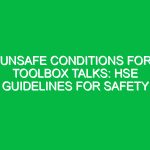Introduction
Falling objects are a significant concern in the Health, Safety, and Environment (HSE) domain, posing serious risks to workers in various industries. Defined as any item that detaches from its original position and descends towards the ground, falling objects can include tools, materials, debris, or even equipment. The consequences of such incidents can be dire, leading to severe injuries or fatalities. By understanding the risks associated with falling objects and implementing effective Prevention strategies, organizations can foster a safer working environment. This article delves into essential Safety tips for preventing falling object Hazards, ensuring that Safety remains a priority in workplaces across the globe.
Understanding Falling Object Hazards
Falling object hazards are prevalent in construction sites, warehouses, manufacturing plants, and even office environments. The potential for objects to fall can arise from several sources:
- Improper storage: Items stacked too high or not secured can easily topple over.
- Workplace activities: Tools or materials dropped during work tasks can lead to accidents.
- Environmental factors: Weather, such as high winds or rain, can dislodge objects.
The impact of a falling object can vary depending on its size, weight, and the height from which it falls. A small tool may cause minor injuries, while a larger piece of equipment can result in severe trauma. Understanding the dynamics of these hazards is crucial for effective risk management in the workplace.
Key Aspects of Falling Object Safety
When addressing falling object hazards, several key aspects must be considered:
Risk Assessment
The first step in preventing falling object incidents is conducting a thorough risk assessment. This involves identifying areas where falling objects are likely to occur and evaluating the potential risks associated with them. Consider the following:
- Evaluate work processes that involve overhead work or elevated surfaces.
- Inspect storage practices to ensure items are not precariously placed.
- Identify high-traffic areas that may be more susceptible to falling objects.
By understanding where hazards exist, organizations can implement targeted solutions.
Use of Personal Protective Equipment (PPE)
Personal Protective Equipment (PPE) plays a vital role in safeguarding workers from falling object injuries. Hard hats, safety shoes, and protective eyewear can mitigate the severity of injuries sustained from falling objects. Employers should ensure that all workers are equipped with the appropriate PPE for their specific tasks. Regular Training sessions on the proper use and Maintenance of PPE can further enhance Workplace Safety.
Securing Tools and Materials
One of the most effective ways to prevent falling object hazards is to secure tools and materials properly. Here are some strategies:
- Tool lanyards: Use lanyards to secure tools when working at heights.
- Storage solutions: Implement shelving, racks, and bins designed to hold materials securely.
- Regular inspections: Conduct routine checks to ensure that storage areas remain organized and clutter-free.
Proper securing of tools and materials can significantly reduce the likelihood of items falling and causing injuries.
Implementing Safety Protocols
Establishing clear safety protocols is essential for preventing falling object hazards. Employees should be trained in these protocols and understand their importance. Protocols may include:
- Designating drop zones and keeping them clear of personnel.
- Using barriers or nets to catch falling objects in high-risk areas.
- Establishing a system for reporting unsafe conditions or near misses.
Regular safety meetings can reinforce the importance of these protocols and encourage a culture of safety within the organization.
Real-Life Examples of Falling Object Incidents
Understanding the impact of falling object hazards is best illustrated through real-life examples. Consider the following case studies:
Case Study 1: Construction Site Accident
In a construction project, a worker was injured when a tool fell from a scaffold due to improper securing. The worker sustained a head injury despite wearing a hard hat. The incident prompted a complete review of safety protocols, leading to the implementation of tool lanyards and mandatory training on securing tools at heights. As a result, similar incidents were reduced significantly in subsequent projects.
Case Study 2: Warehouse Incident
In a warehouse setting, several boxes were stacked too high without proper securing. During a shift change, an employee inadvertently knocked one of the boxes, causing a cascade of boxes to fall. Fortunately, no injuries occurred, but the incident highlighted the need for better storage practices. The warehouse management introduced a new policy requiring boxes to be stored below a certain height and implemented training for all staff on safe stacking techniques.
Regulations and Standards Governing Falling Object Hazards
Various Regulations and standards govern the Safety Measures necessary to prevent falling object hazards. In the United States, the Occupational Safety and Health Administration (OSHA) provides guidelines that employers must follow to ensure Workplace Safety. Key regulations include:
- osha Standard 1926.501: This standard outlines Fall Protection requirements for construction workers.
- OSHA Standard 1910.28: This standard addresses fall protection for general industry.
Compliance with these regulations is not just a legal obligation; it also demonstrates a commitment to worker safety. Employers should regularly review these standards to ensure that their safety practices align with current regulations.
Best Practices for Preventing Falling Object Hazards
To effectively mitigate the risk of falling object hazards, several Best Practices can be adopted:
1. Conduct Regular Training
Training is crucial for informing employees about the risks associated with falling objects and the measures they must take to protect themselves. Regular safety workshops can help reinforce these messages and keep safety top of mind.
2. Promote a Safety Culture
Encouraging open communication about safety concerns can foster a culture where employees feel empowered to report hazards without fear of repercussions. This proactive approach can help identify potential risks before they escalate into incidents.
3. Utilize Technology
Advancements in technology can aid in preventing falling object incidents. For example, using drones for inspections can help identify hazards at heights without putting workers at risk. Additionally, employing sensors and alarms in high-risk areas can alert personnel to potential dangers.
4. Perform Routine Inspections
Regular inspections of work areas can help identify unsafe practices or conditions. These inspections should involve checking for unsecured materials, evaluating the condition of equipment, and ensuring that Safety Measures are being followed.
Conclusion
Falling object hazards represent a serious risk in the workplace, demanding attention and proactive measures to prevent incidents. By understanding the nature of these hazards and implementing essential safety tips, organizations can significantly reduce the likelihood of injuries. From risk assessments to securing tools and materials, every action taken contributes to a safer work environment. Staying informed about regulations and fostering a culture of safety are critical in promoting health, safety, and environmental Sustainability. As we move forward, let us prioritize the prevention of falling object hazards to ensure that every worker returns home safely each day.


